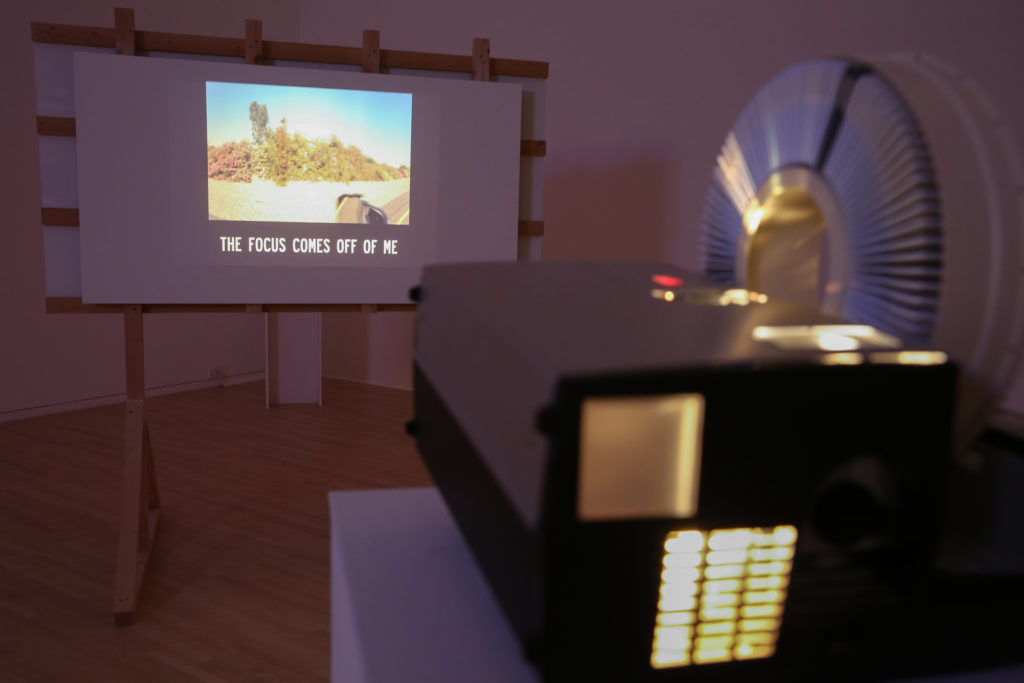Demian Dinéyazhi: The Henry Art Gallery
by Luke Fidler
Demian DinéYazhi’ (Diné) is the latest and last recipient of the Brink Award—given biennially to Northwest artists under the age of thirty-five—and is the first to make Native life central to their practice. Through zines, stickers, Instagram posts, and a well-stocked Etsy store, DinéYazhi’ has advocated powerfully for intersectional forms of queer Indigenous resistance. They repeatedly point out the museum world’s shortcomings when it comes to marking and supporting such forms, and scrutinize past and present examples of Native representation that would constrict rich, expansive identities. “I feel othered in my masculinity when it comes to Indigenous gender,” DinéYazhi’ has remarked and, alongside artists like Kent Monkman (Fish River Cree), they have interrogated how thoroughly gendered the long history of romanticized Indigeneity has really been.1 All this to say; there is a strong polemic at work in DinéYazhi’’s exhibition entitled Galéé Sin and unpacking or assessing it requires some knowledge of the tangled genealogies of land, identity, and spectatorship—not to mention the fraught politics of settler colonialism that have traditionally subtended the whole business in North America.

It is beyond the purview of this review to properly frame these genealogies and politics which is partially—in my view—the point of the work. To enter the exhibition is to enter a world that has traditionally been excluded from predominantly white, high-art museum spaces where critics are more comfortable debating the merits of high modernism than the vexed discourse of Indigenous sovereignty.2 Most of the gallery space is taken up by a series of slide projections which show photographs overlaid with text, the dizzying juxtaposition of moving images making it difficult to see more than snippets at a time without some real self-control: “like creation stories,” “never bound,” “or invented borders,” “to be diasporic,” “how they have assumed a simulated reality,” “an indigenous body that stops the pipeline.” The captions accompany images of fire (Traveling Song [For All My Relations Who Will Become Womxn]), landscapes from the southwest (NEVER NO MORE), and pure red (HEY JOLENE). They clearly foreground a set of experiences and tragedies that have little to do with standard gallery fare. This in turn serves as a reminder that much contemporary art made by Native practitioners has explicitly challenged the aesthetic standards of the highbrow western world—see the work of Nicholas Galan (Tlingit) for a telling example—and that, while DinéYazhi’’s work fits neatly into a series of superficial precedents, it also does something quite different than the slide projections of Steve Rowell or the neons of Bruce Nauman. If you watch each series from start to finish, you are forced to digest (or try to digest) a poetic reflection on the visual culture of colonialism which is sometimes jarringly raw and sometimes too heavy-handed to really keep your interest. But as I watched, I slowly realized that these works speak less to devotees of Nauman and co. than the younger generation of artist-activists who have increasingly populated sites like Standing Rock with inventive, politically-attuned reworkings of modernist traditions. Still, the show is most persuasive when the installation is taken as a whole and the snippets’ cumulative weight starts to state the case for understanding a wide range of struggles and histories as vitally interconnected.
If we go by the titles, DinéYazhi’ seems preoccupied with problems of past and future. Alongside those mentioned above, consider the pieces, The Memory Before the Memory and in beauty it is restored. The texts appearing in the works themselves repeatedly gesture to what has come before and what comes next, in keeping with the artist’s broader project of reimagining the future conditions of Native life. They implicitly argue that changing the future means changing the past, squaring both with the revisions of Native history underway since at least Vine Deloria Jr.’s 1969 classic, Custer Died for Your Sins: An Indian Manifesto, and Mark Rifkin’s important observations about sexuality and Native kinship in When Did Indians Become Straight?3 But how exactly does the past fit with DinéYazhi’’s art? A television monitor—neither plasma screen nor projection, perhaps hinting at the importance of television in the radical politics of the sixties and seventies—by the entrance cycles footage from the occupation of Alcatraz by a group of Native activists beginning in 1969.4 They are commonly misidentified as members the American Indian Movement (AIM), a group skewered by later Native activists for their machismo and whose legacy has been increasingly called into question by artists of later vintage, and I wonder if DinéYazhi’ has purposefully singled out this action rather than other, more muscular AIM actions from the seventies.5
Is this a purposeful recasting of the recent history of Native resistance? Moreover, the projectors I noted earlier, rotating 35 mm slides made from digital photographs, clearly invoke an older way of making and beholding images. I suspect that the exhibition’s reference to the past comes off with less precision than the artist might wish; that is to say, the pairing of a specific, datable action at Alcatraz with looser invocations of a pre-digital era blunts some of the propositions about colonialism, a force that, for all its omnivorous hunger, is carried out by nameable folks at definable times. The temporal targets shift throughout the show. But to quibble about precision in a show that so effectively conveys the raw hurt of history seems trivial.

A key aspect of the show’s presentation, and one that seems the most troubling, is its putative conscription of the viewer into forms of consensus. By Entering This (Indigenous) Space is one of two works on the TV monitor, and it consists of a scrolling text (a version of which has been previously installed by the artist in vinyl) that directly addresses the viewer. “By entering this space,” it begins, “you have an ethical responsibility to acknowledge that all Indigenous thought, creativity, fantasy, activism & existence is grounded in continual acts of Survivance.”6
So far so good. Viewers in the Henry do have these ethical responsibilities, and even if they lack some of the knowledge or tools to fulsomely acknowledge these issues, DinéYazhi’’s other works promise to impart enough to set these acknowledgements in motion. The text’s conclusion, however, is a little more difficult to make sense of: “By entering this space you have agreed to become a lifelong against humanitarian & environmental injustice.” It is unlikely that most viewers will, in fact, honor their share of the bargain. More to the point, what does it mean to impose such burdens on museumgoers? What does it mean to construe an installation as a site for producing and enforcing such all-encompassing agreements?
The answer, of course, is troubling not only to common-sense notions of transacting agency, but also to the long-standing idea of museums as spaces of white exceptionalism. The work’s form of unabashed direct address should trouble viewers, should make them aware of the impositions they already consent to, should make them aware of the fact that living in the United States has generally been taken to mean that you promise to learn the history of Andrew Jackson rather than Nanyehi Ward (Cherokee). And so, if this show has its uneven moments, it is a series of vital interventions that materially make one museum a little less white.
The Brink: Demian DinéYazhi´ runs at the Henry Art Gallery until September 8, 2018.
- Quoted in Caitlin S. Cooper, “More Than Two-Spirit: Queer Indigenous Sovereignty and Survivance in Museums” (M.A. Thesis, University of Washington, 2017), 25.
- The bibliography on this topic is large; key recent works on the Native North American context include: Gerald Taiaiake Alfred, “‘Sovereignty’ – An Inappropriate Concept,” in The Indigenous Experience: Global Perspectives, ed. Chris Andersen and Roger C.A. Maaka (Toronto: Canadian Scholars’ Press, 2006), 322–36; Joanne Barker, ed., Sovereignty Matters: Locations of Contestation and Possibility in Indigenous Struggles for Self-Determination (Lincoln: University of Nebraska Press, 2005); Glen Sean Coulthard, Red Skin, White Masks: Rejecting the Colonial Politics of Recognition, Indigenous Americas (Minneapolis: University of Minnesota Press, 2014); N. Bruce Duthu, Shadow Nations: Tribal Sovereignty and the Limits of Legal Pluralism (New York: Oxford University Press, 2013); Audra Simpson, Mohawk Interruptus: Political Life Across the Borders of Settler States (Durham: Duke University Press, 2014). For an art historical discussion of these issues, see my “Sorting Sovereignty,” Art Journal (forthcoming).
- Respectively: Vine Deloria Jr., Custer Died for Your Sins: An Indian Manifesto (Norman: University of Oklahoma Press, 1969); Mark Rifkin, When Did Indians Become Straight? Kinship, the History of Sexuality, and Native Sovereignty (New York: Oxford University Press, 2011).
- See, for example: Kara Keeling, The Witch’s Flight: The Cinematic, the Black Femme, and the Image of Common Sense (Durham: Duke University Press, 2007), 68-94.
- Jessica L Horton, Art for an Undivided Earth: The American Indian Movement Generation (Durham: Duke University Press, 2017).
- “Survivance” likely refers to the special sense in which the term is employed in Native American Studies. See especially Gerald Vizenor, Manifest Manners: Postindian Warriors of Survivance (Hanover: University Press of New England, 1994).